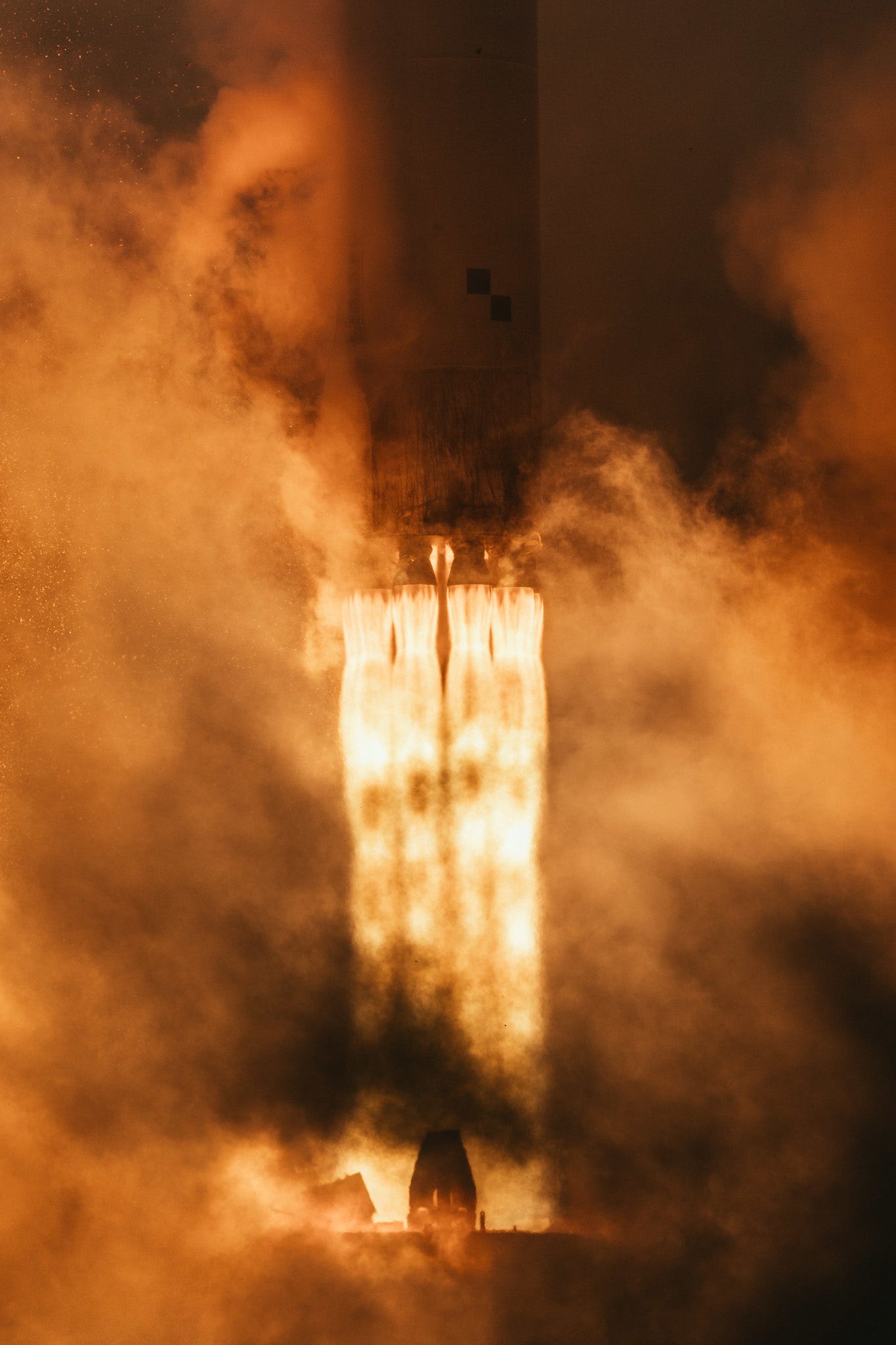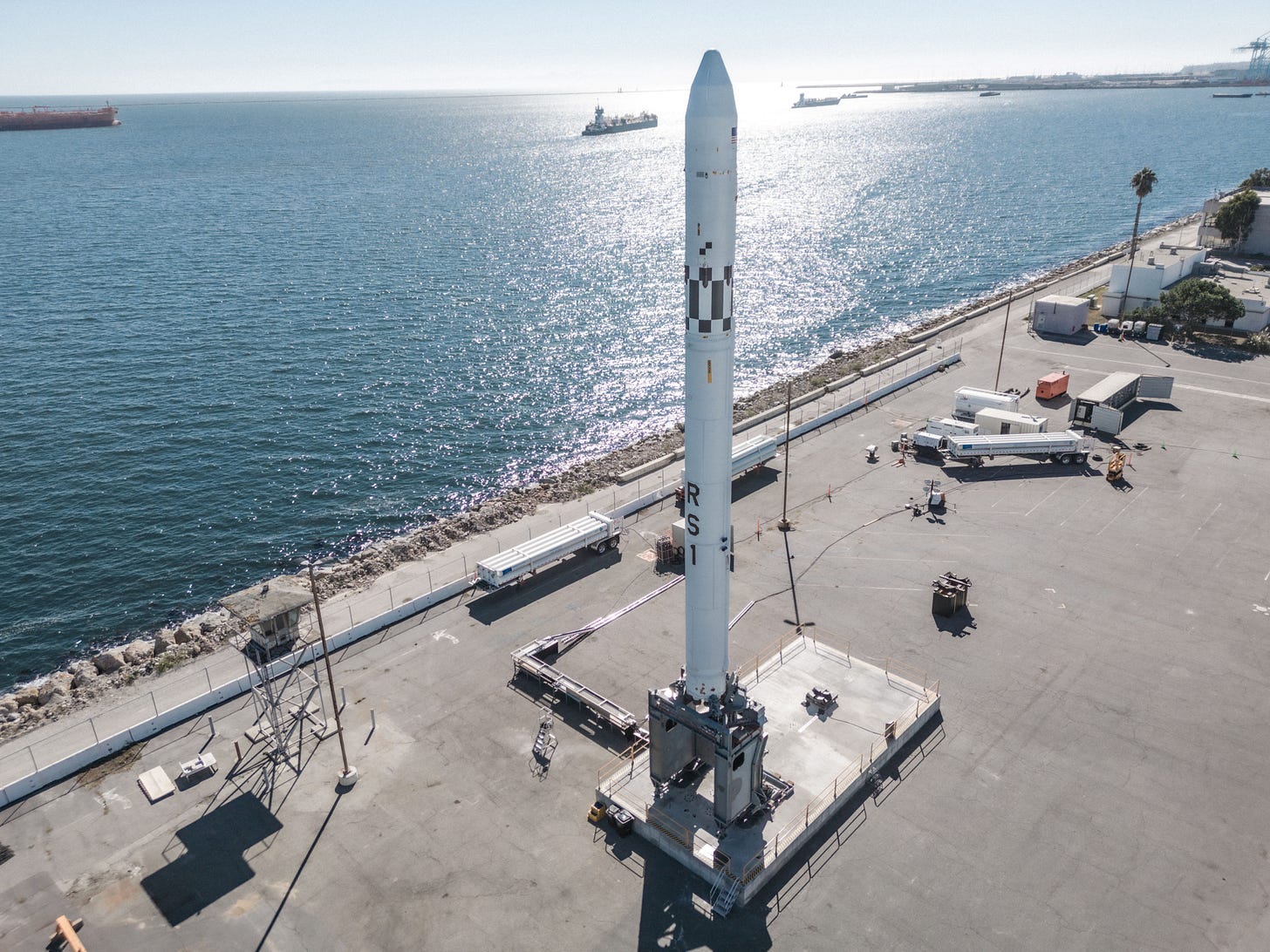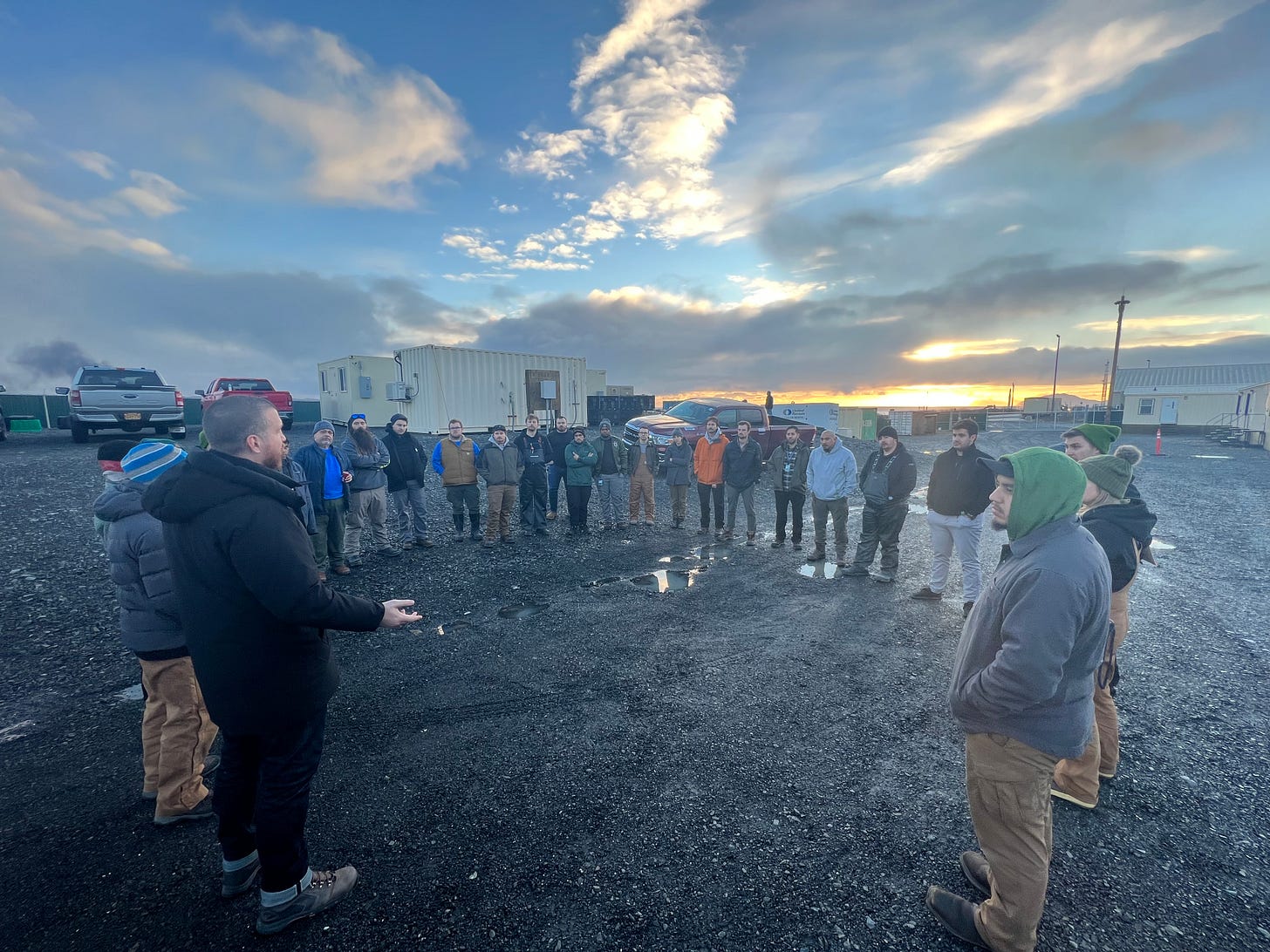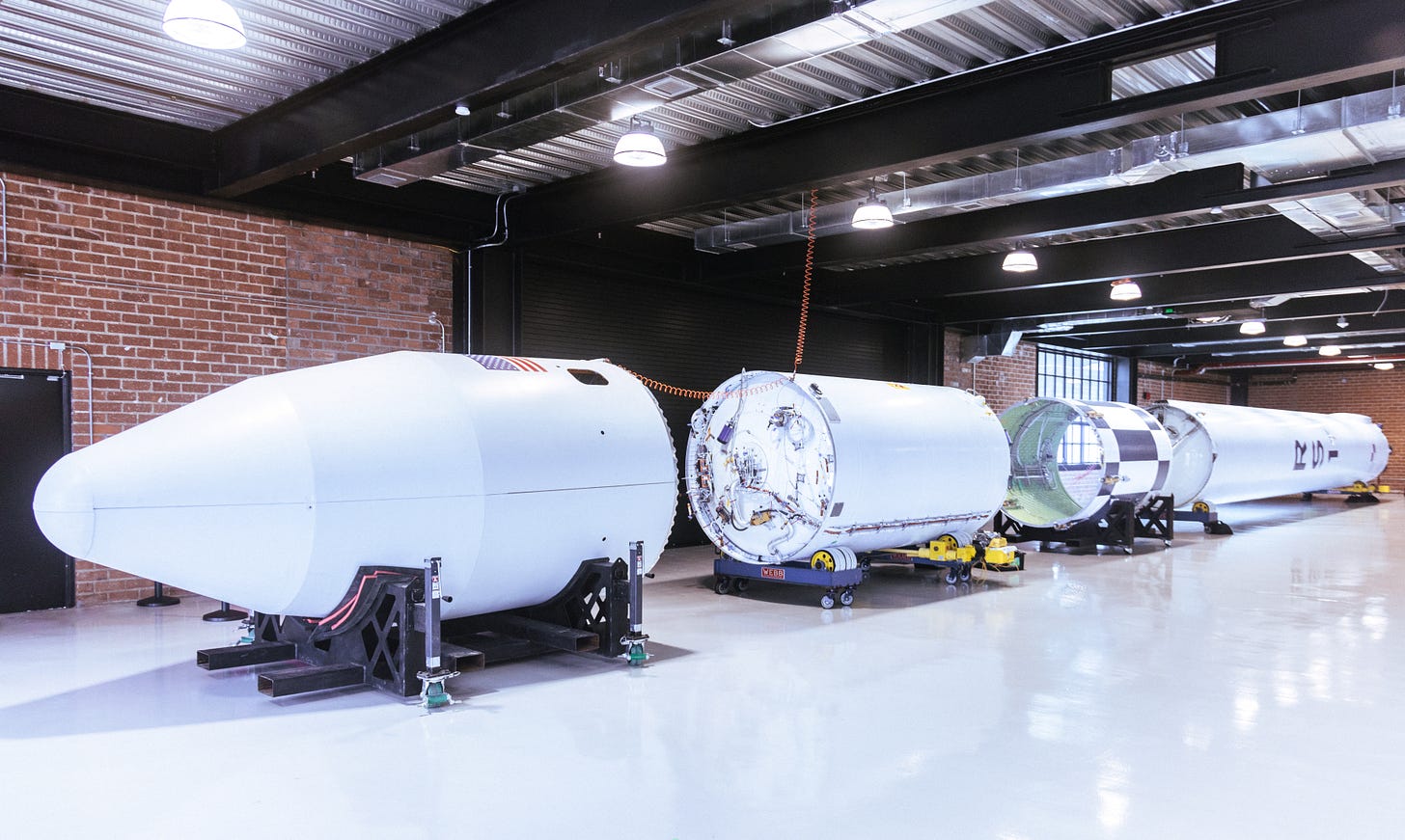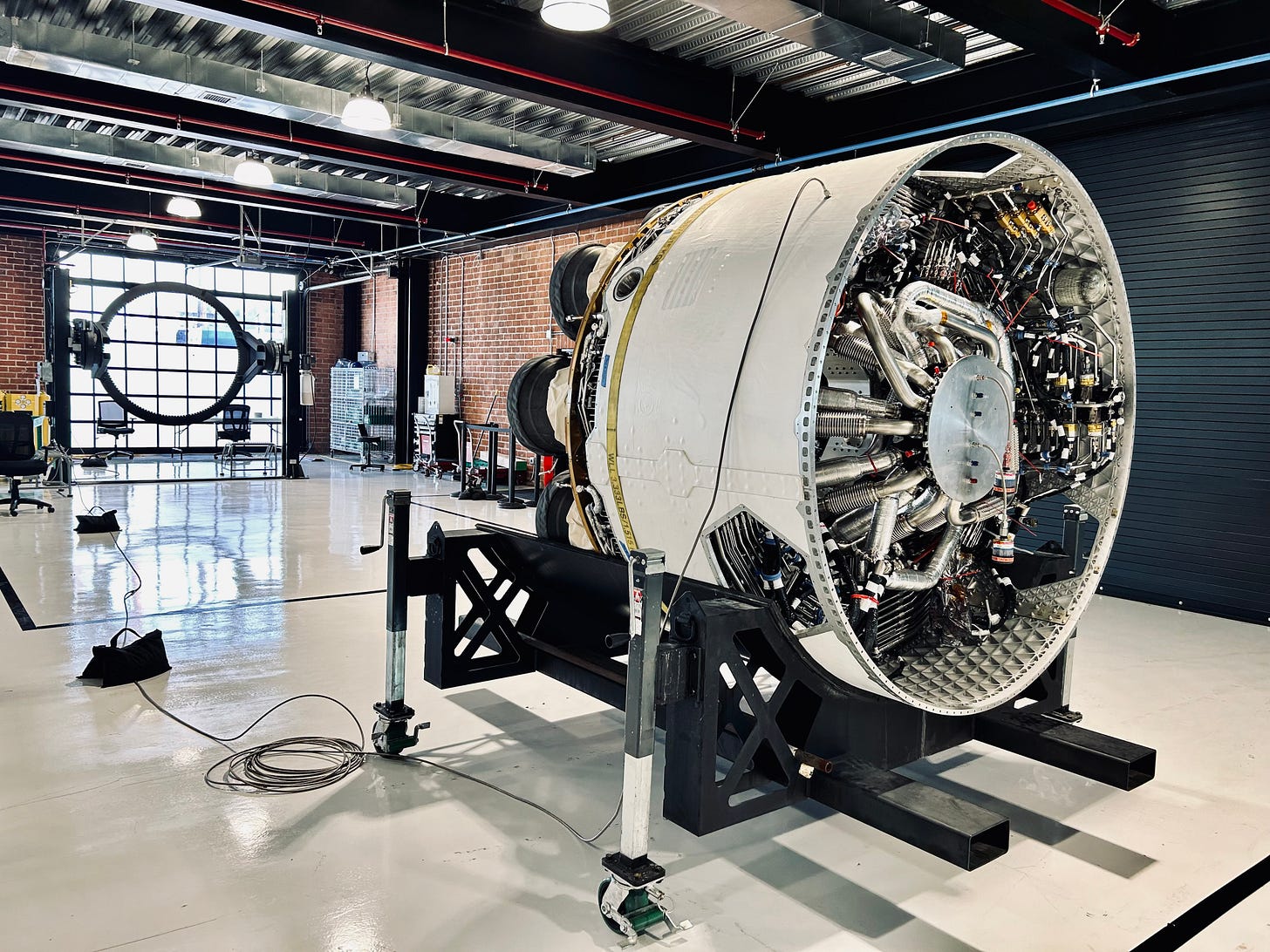The Road to Flight 2
A vertical vehicle on the pad is majestic. When T0 hits, the thunder of the engines is awe-inspiring. It all comes together in this one moment, but it’s the many thousands of hours put in over the months prior that define success or failure. When I reflect on this dynamic, Muhammad Ali’s famous words resonate, “The fight is won or lost far away from witnesses - behind the lines, in the gym, and out there on the road, long before I dance under those lights.” Flight 2 is approaching and this is the story of our path to get there.
We devoted this year to preparing for the mission. It was tedious work and often not glamorous. It was also executed against the backdrop of a failed launch. We knew the odds going into Flight 1. All modern new launch vehicles from new companies have failed on their first flight. Even still, the outcome hurt. But it was a powerful tool. Failure forces everyone to reaffirm their conviction. It filters out those that don’t and drives hunger into those that do.
Our Flight 2 preparations recently tied together in an integrated operation called Dock Dress. This is one of the last major California activities before systems deploy to Alaska for launch. It’s an exciting milestone and a logical point to reflect on our work this year.
The Systems
The story centers around ABL’s flagship systems: the RS1 launch vehicle and the GS0 ground system. RS1 is 1-ton class launch vehicle. Sized to fit in a shipping container, it’s ultra-transportable. It boasts an all metallic primary structure, gas generator cycle engines and liquid oxygen / Jet-A propellants. Simple and proven, these architectures makes the vehicle robust and low-cost.
GS0 is a modular ground system. Put another way, it’s a launch site in a box. While RS1 is often the star of the show, GS0 is our operational backbone. It uniquely positions us to provide resilient launch to the U.S. Government, as well as flexible, low-cost launch to commercial and international markets. Imagine this: a convoy of container trucks arrive at a parking lot. A few days later, it’s an orbital launch site. That’s RS1 and GS0.
Flight 1
Our journey started with Flight 1, which lifted off from Kodiak, Alaska on January 10th at 15:27:30 local. It took us five years from founding the company to launching the rocket. Needless to say, seeing the vehicle clear the pad was incredible. Everything we had worked towards came to life. Engine startup and bootstrap were exactly as expected. The hold down release was flawless. The flight software and control systems maintained steady vertical flight.
Unfortunately, the joy was short-lived. As we would come to learn through our investigation, an aft end fire started early in flight. It burned through a set of electrical wires, which cut power and shut off the engines. We lost the vehicle and damaged the pad.
Our ops team circles up at the beginning and end of each day. The post-launch circle up is one that I’ll never forget. We were all processing what was a very difficult outcome. It didn’t feel representative of the hard work and thoughtfulness we had put in. We’d been so careful and methodical. We wanted more, but we didn’t get it.
That day we were reminded why launch is so difficult. One miss will overshadow thousands of wins. Yet, the fact that it’s so difficult is the same reason it’s a worthy pursuit. Delivering mass to orbit is a true challenge, but for our economy, our national security and the pursuit of human exploration, we need to do it.
Investigation
The next day, we launched an internal anomaly investigation, spearheaded by a cross-disciplinary task force. Our immediate focus was evidence collection and data alignment. We organized a mass of information onto a master timeline to start making sense of it all.
Our goal wasn’t necessarily to whittle everything down to a single conclusion. In anomalies like this, there is often a predominant issue that becomes the leading root cause. There is also usually a handful of plausible alternatives and a longer list of undesirable conditions. We work to understand them all and set improvements for each.
Process is important and we built a comprehensive fault tree. In it, we considered each RS1 and GS0 system and evaluated if it had operated nominally. Systems that had faults were highlighted and underwent more detailed scrutiny. Soon, a series of events emerged:
A fire started in the Stage 1 aft end and burned through certain wire harnesses. By considering the order in which devices lost power, we pinpointed the location of the wire breach.
The damaged wire harness caused a loss of power to Stage 1.
The loss of power closed our propellant isolation valves.
The closed propellant isolation valves shut off the engines.
By analyzing video and data, we formulated a leading theory behind the source of the fire. Our hypothesis centered around the Launch Mount, which is the GS0 assembly that raises and lowers the vehicle. It was designed to fit fully assembled inside a shipping container. While this made transport simple, it resulted in the rocket being held close to the ground.
We believe the compact Launch Mount and proximity of RS1 to the ground restricted the flow of engine exhaust gas. This caused plume recirculation and drove pressures and temperatures beneath the rocket to exceed the RS1 base heat shield design capability. The hot combustion gases breached the aft heat shield and initiated the engine compartment fire. We corroborated this theory with a variety of tests and analyses, including multi-species CFD performed both in-house and by an independent partner.
We’re confident in this theory, but are cautious not to be over-confident. Other theories and off-nominal conditions are receiving the same level of scrutiny. Flight 1 wasn’t successful, but it gave us significant new data. We’re working tirelessly to make sure we understand it all before Flight 2.
External Independent Review Board
To gain outside perspective and ensure we didn’t overlook anything, we convened an External Independent Review Board (EIRB). The group was comprised of ten industry experts, with backgrounds spanning SpaceX, Lockheed Martin, United Launch Alliance, Blue Origin, NASA, Virgin Orbit and many more.
Beyond gathering the best minds in one room, we also sought to deliver transparency and insight to our partners. We invited many of our commercial and government customers to participate. This provided them direct visibility into the technical program and positioned our teams to collaborate on upcoming missions.
The EIRB began with two days of presentations at an offsite conference center. We modeled the format after a Senate hearing to drive formality and rigor into the sessions. It had been about eight weeks since Flight 1, providing ample time for deep data review. Each ABL team presented their findings to the panel, who didn’t hold back with their questions and inquiries.
The event injected new perspectives that raised the bar. We refined our baseline theory and explored other possible scenarios. The discussions drove new tests and analyses, which led to vehicle upgrades and a Launch Mount redesign. Beyond technical matters, we identified programmatic improvements.
The EIRB was also validating. It highlighted what we know are the core strengths of ABL, including a determined team, quality designs, and mature process control. Through all of this, the event began the process of turning a negative outcome into positive growth. RS1 and GS0 became better systems and ABL a stronger company.
Launch Mount
Our goal for the Launch Mount redesign was to prevent plume recirculation while still enabling the assembly to be easily transported. To do this, we increased the height, width and exhaust area. We vetted the design with further CFD analysis and external review. Instead of shipping as one unit, we modified the design to transport in three major pieces. These bolt together in a few shifts, which meets our rapid site activation requirements.
Over the summer we built and tested the Launch Mount. The assembly uses standard I-beams and is designed for streamlined welding and inspection. After manufacturing, we moved the Launch Mount to our structures test pad for a strenuous battery of proof load and commissioning tests. Pictures and video don’t do justice. The Launch Mount is a highly mobile monster. It effortlessly lifts RS1 and will keep it safe while on the ground.
RS1 Block 2
RS1 took a different path coming out the EIRB. Before Flight 1, we had built two Block 1 configuration vehicles. One flew in January, while the other was in the factory as a backup. Because it was ready, we initially planned to fly the backup Block 1 vehicle for Flight 2. After that, we had a pre-planned upgrade to Block 2, which incorporates a variety of changes to make the vehicle production ready.
After a few months of progress, we got better visibility into the readiness timelines for the Launch Mount and the launch site. It became clear that there was slack in the RS1 schedule. We had an opportunity to move directly to Block 2 for Flight 2, which we chose to pursue. The Block 2 upgrades improve manufacturability, performance and reliability:
20% higher thrust
20% more propellant
Detachable Stage 1 Aft Module
Modular Stage 1 engines
Lightweight Stage 1 tank
This strategy added significant design scope to the Flight 2 roadmap. However, moving straight to Block 2 is a more direct path to building flight heritage on the configuration that will carry customer payloads to orbit.
Engines
The first major Block 2 change comes in the E2 Boost engines, which we repackaged to reduce integration time and improve testability. With the new layout we can connect an engine to the vehicle in just a few hours, which sets us up to ramp production. The design also incorporates an integrated heat shield with overlapping joints. This increases the shield’s robustness, while preserving a favorable mass fraction.
Stage 1 continues to use nine radially arranged engines and we’ve also added a double barrel center engine, which increases overall thrust. Both Block 2 engine configurations use the same thrust chambers, injectors, turbopumps and gas generators as Block 1. We’ve built about forty total engines. Through hundreds of engine starts and tens of thousands of hotfire seconds, we’ve established significant heritage on the E2 engine design.
Aft Module
For Block 2, we made the Stage 1 engine section detachable from the tank. This is a critical manufacturability improvement since the Stage 1 aft end is the most crowded and complex region of the vehicle. In the new design, access for integration is plenty, allowing many hands to work on the assembly at once. The module is mechanically fastened to the Stage 1 tank, which can be optionally performed in the factory or in the field.
Our design language shines on the Aft Module. It takes iteration for an organization to converge on common design practices - how tubing nests together, where access points are, what brackets look like. We’ve made steady improvement over the years and it all came together here.
Stage 2
On Stage 2, we performed our standard acceptance test campaign. This highly refined operation simulates day-of-launch and flight conditions. We load propellant onto the vehicle using GS0, just as we do at the launch site. We use the same software sequences that control the vehicle in flight. This test-like-you-fly approach de-risks the mission and screens for any issues that could present on the pad.
Fairing
Equally as important as the stages, the Fairing previously underwent extensive testing. The structure was load proofed and the avionics system checked out from end-to-end. The campaign culminated with ground functional testing. We energized the low-shock hold mechanisms, allowing the spring pushers to separate the Fairing halves to verify the kinematics.
Mission Assurance
Mission assurance is a top priority and we carefully tailor our activities to each mission’s target risk profile. For Flight 1, we performed an extensive battery of ground tests to validate our systems. This included about ninety five engine and stage tests, fifteen fully stacked vehicle operations and thirty sub-scale tests. Through these, we vetted everything from structural load capability to propulsion system flow capacity to ignition timing.
Beyond test, we also executed a variety of hazard analyses, such as for engine startup. In this case, we considered the consequence of failure for each component at each phase in the sequence. Using this framework, we tuned operations and architected abort paths to protect the vehicle.
To verify our avionics and software systems, we built up a Hardware-in-the-Loop (HITL) testbed. This enables us to test every flight software build before loading it onto the rocket. Additionally, our algorithms underwent independent code review to audit for bugs and inconsistencies. Combined, these are some of the tools we used to take calculated risk on the Flight 1 development vehicle.
For Flight 2, we have further evolved our mission assurance. We’re on different footing after all the Flight 1 activities, which positions us better to perform reviews. We’ve executed a portfolio of internal and external audits across all technical domains. We also expanded our Independent Validation and Verification (IV&V) efforts from code review to a complete third party simulation of our flight software and guidance algorithms.
We’ve also built out new parts of our organization and upgraded key risk management systems. These elements help us to oversee the many technical aspects of our program. Looking forward, just as we will scale production, we’ll also be constantly scaling our mission assurance activities to execute flights with increasing complexity.
Dock Dress
All of these efforts came together in Dock Dress. We integrated RS1 to GS0 to check mechanical fit up and perform integrated checkouts. These include polarity tests to ensure the engines move in the proper direction and vehicle hardware-in-the-loop tests to vet flight software directly on the flight hardware.
We also practiced our ground operations. We got repetitions in mating RS1 to the Launch Mount. We familiarized our team with the procedures for all Remove Before Flight caps and plugs. Additionally, throughout the week, we raised the vehicle vertical dozens of times under the command of different operators to build depth in our roster.
The fact that we can perform such a high degree of integrated testing at our factory is a key operational advantage of our mobile systems. The campaign involved the exact hardware that will be used for Flight 2. By the time the units are in the field, there will be significant heritage on them.
What’s Next
Dock Dress readied RS1 and GS0 for shipment to Alaska. GS0 will head to Washington where it’ll meet a cargo ship to Kodiak. RS1 will undergo a few more checkouts before also heading north.
Most other equipment is already in Alaska. This includes cross country lines, propellant tanks and gas trailers. We’ll complete a series of RS1 and GS0 checkouts in Alaska and then step into Stage 1 static fire. This will be the final verification of Stage 1 and the upgraded Launch Mount. After that, we’ll go for launch.
It was not in our plans to have RS1 grounded for most of 2023. Our philosophy is to scale launch cadence quickly, pursuing iterative development cycles with a hardware rich approach. Circumstances pushed us in the other direction this year. Many upgrades were implemented at the same time during a long operational pause. Our team rose to the challenge and delivered upgraded flight articles in nine months. This prepares us well and sets a strong baseline for future RS1 and GS0 upgrade cycles. It also keeps us ahead of the curve, with Flight 2 coming around six years into our program and a full block upgrade production design in hand.
Our efforts this year were far away from the pad lights. They’ve been meticulous and executed by a flight-seasoned team. This post highlights but a few examples of our team’s work this year. In doing so, it risks doing a disservice to the countless other accomplishments not included. I’m proud of everything our team has achieved and inspired by the hard work put in by every single group across the company.
Most of all, I can’t wait for our next circle up in Alaska.


